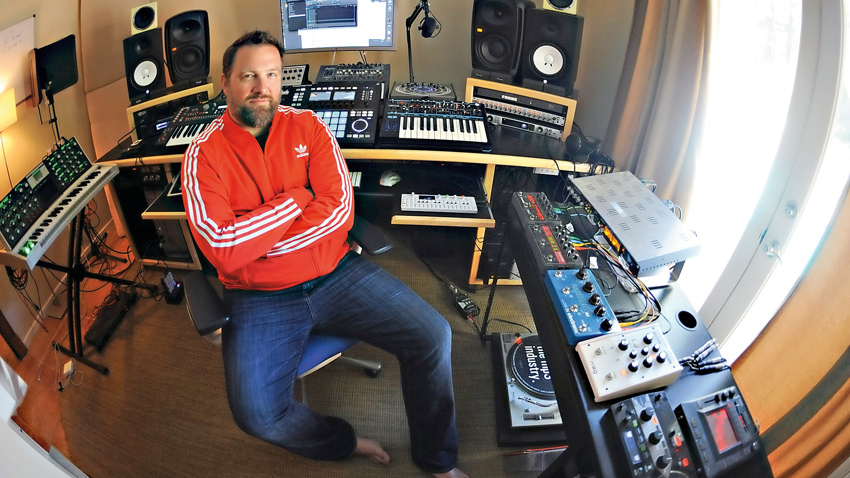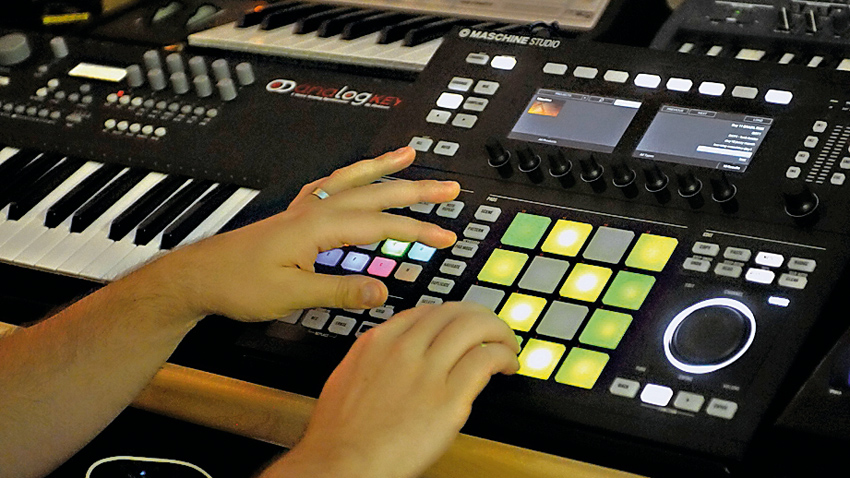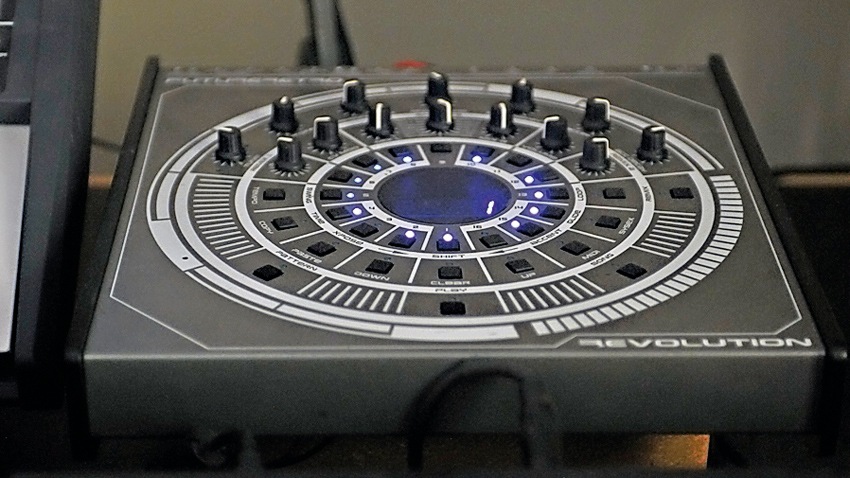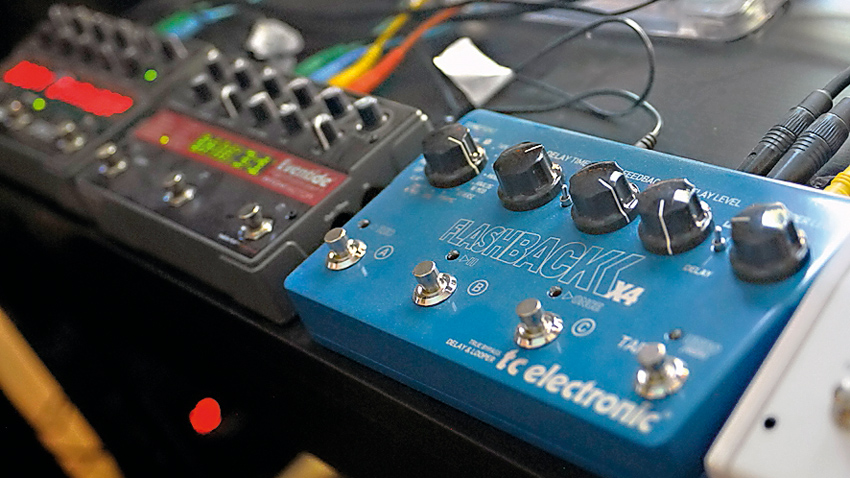Claude VonStroke talks production, DJing and new album Urban Animal
"I'm just not interested in getting into stuff that sucks tens of thousands of hours from your life. I just wanna make songs."

On paper, it might not seem like Barclay Crenshaw (aka Claude VonStroke) has been that busy since the release of his last album, 2009's Bird Brain. In reality though, a steady stream of remixes, collaborative singles, and DJ gigs - not to mention his family life - have all kept him in motion. Oh, and that's to say nothing of his label, dirtybird, and its charity sister outlet, mothership.
The pace is such, in fact, that when we bump into Crenshaw during his recent trip to Asheville, North Carolina, to perform at the inaugural Mountain Oasis Electronic Music Summit, he barely has time to turn up for his gig, sleep, and take a quick tour of Moog Music HQ before he's off again. It's unsurprising then that, when it came to finally settling down to his next record, Crenshaw took no more than eight months to do it from stem to stern.
"That's crazy fast for me," Crenshaw explains. "The other two albums took a year and a half, at least. I'm a super-slow producer. I like to really nitpick the tracks... a little too much."
The resulting album is a rather different beast. Urban Animal is at several points more sedate, a bit darker and has more of a futuristic, hip-hop inflected vibe than his last.
A dedicated Future Music reader, Crenshaw never seems to be above expanding his knowledge and sharing it with others. Not only has he taken professional production classes to sharpen his skills, but he has recently started dissecting some of his own tracks via his YouTube channel.
It's been four years since the last proper Claude VonStroke album. Why such a long gap?
"I did like 20 remixes in those few years there, then there was a remix CD because I'd spent as much time making these remixes as two albums. But they were remixes that I thought had been redone so much that they were kind of like original tracks. That was called Makeovers.
Want all the hottest music and gear news, reviews, deals, features and more, direct to your inbox? Sign up here.
"I'm a super-slow producer. I like to really nitpick the tracks... a little too much."
"The chain is that every year and a half or two years there's a CD, and then there's singles all spread out and remixes. But there isn't really a gap if you look at everything. There is a slight gap of me touring like a madman but it's not that bad."
Is that why Urban Animal came together fairly quickly once you got going?
"Yeah, it's the fastest album that I've ever made. It's also the shortest. I did all the hard work in six months and then had probably another two months of getting the mixdowns right and radio edits and whatever else. I have two children and a full touring schedule and a record label. So yes, it's crazy. I did it in eight months... the whole thing."
Was the set up the same as on Bird Brain?
"Less Reason than before. I'm trying to record into it more but [as far as] moving things around and such it's still just Ableton [Live] 9. What I did use a lot is Native Instruments Maschine. It's the best scratchpad ever for just whipping up an idea, and then it's terrible for trying to integrate it back into your DAW.
"The Maschine Studio thing is awesome as it has screens on it and you don't even have to look at your computer, but it would be better if they would just add audio to it. Then they would have a Reason-like thing, because it's pretty cool and it's fast. Say you want to put together a beat in Ableton, you can do it in either 40 minutes or five minutes; Maschine is the five minute version and it's fun."

Has your workflow changed at all?
"I'm trying to get faster, so I'm working more on Maschine because I find that the ideas come way faster. I do what I call the scratchpad work in Maschine and then once it gets into skeleton form I then do all the nitpicky stuff in a DAW, like automation and everything. But I also want do a lot of this analogue synth sequencing and just tweak the knobs and record for 20 minutes, and then just pick out the best three minutes."
Have you got an analogue keyboard to do that with?
"I just got this Moog Sub Phatty, which sounds a lot nastier than the Voyager. Then I got this thing called the Future Retro Revolution which is a TB-303 emulator and looks like a sundial. It's a sequencer with CV gate and all that old-school sequencer stuff like glide notes. I just got that off eBay today."

Are you at all inclined to work in the modular realm now that it's growing in popularity these days?
"No, I'm just not interested in getting into stuff that sucks tens of thousands of hours from your life. I wanna just make songs. When I started out, I used to make every sound from scratch. I had a Nord Modular and I found that it was very instructive, but it's not very good for making music when you make every sound from scratch. There are a million weird sounds, but you end up using the same tones a lot of the time for bass. And there's no reason to recreate the sub bass sound or a nice kick drum. You can just waste your time on other stuff."
How are things shaping up on the outboard processor side of things?
"I have this whole signal chain. It's called the Dangerous Music Liaison. It's basically a patch bay switcher. I also have an API 2500 Compressor, and a Thermionic Rooster. So with the Liaison I can hit button number one to go through the compressor, button number two to go through the tube pre-amp, and then I can deselect them and go to button number three to go to a Kaoss Pad. Button four will go through the Eventide Space and PitchFactor, button five goes through a Sherman Filterbank and button six goes through this Pioneer RMX-1000.
"I'd like to redo that chain to have a guitar pedal thing in it, but basically I can route anything out of Ableton and then back in and just hit whatever buttons I need to do real-time effects."

How did you come up with that electro melody in Urban Animal's title track?
"That's the u-he Diva plug-in. I just played a melody into the computer with a MIDI controller and then stuck the Ableton Arpeggiator on it and then I just fiddled with the knobs until it sounded cool. That's it.
"The cool part of that sound is that I flattened it because my computer is six years old and that specific synth is a crusher on the computer. I recorded it three different ways and then I flattened them all. A lot of the stuff that happens on that line is after it was flattened, by chopping it up right on the timeline afterwards, like post processing."
How did something like Dood come together?
"I'm always trying to make tracks that have funny ideas but they're serious, kind of like [Cajmere's] Percolator. That's a really cool track but it's kind of a funny idea. So Dood was gonna be like a California surf techno song and so, that's what it is, if you listen to it. But I decided that the synth lines needed to just be analogue. There is one VST in it which is the u-he Diva. The bassline is a Rob Papen SubBoomBass and then it's mirrored by an organ from my Roland Phantom. All these crazy sounds on there are lines from the Moog Voyager and an Arturia MiniBrute.
"That was the first time on this album where I was sequencing the analogue synths out of Ableton and then recording them back in and chopping them up. I had done most of the other tracks in the box before but I was actually doing full lines with this track, which I really enjoyed. It was a lot of fun just tweaking the knobs in real time. It's really inspired me to get a few more things and start new stuff now that uses more of that fun style of recording. You're actually doing something instead of just doing math equations."
Was that kind of intimidating to wire up that stuff and do it outside of the box?
"I did have a guy come over to help me - Taylor Marter. I'm pretty good but there were a couple things where I was like, 'Man, I don't know what I'm doing.' It's not always in sync, you've gotta kind of nudge it over when you're done. It doesn't seem like that whole thing is perfected yet. Maybe someone's got it perfected, but not me."
The Clapping Track sounds like it might have been difficult to put together. How did that come about?
"I got the sound of a bunch of people clapping; literally, that's what it is. Then I put 16 individual claps on an Ableton Drum Rack and triggered them using the Maschine pads. I reprogrammed the claps to be a rhythmic pattern instead of just a jumble and then I brought the original track back of everybody clapping, so it almost sounds like I'm pulling the claps back to where they're messy again. I start with a pattern and then it just morphs into just a bunch of people clapping. That's one of my tricks that I do. It's like the track Deep Throat, where I'm either dissecting or putting sounds back together in a beat, and then the organ is basically just a bunch of layers of old Hammond organs."
There's also a similar bit of organ that shows up on The Bridge. Is that from the same set of samples?
"You know what that one is? That's a (GSi) VB3 plug-in. It's like $30, and it's the best one. I just played that melody; one of my favourite things to do is to play a melody and filter it, and record it, like, six different ways and just play with volume envelopes. I like to bring different timbres in and out, so it's almost like the patch is morphing, but really it's just me playing it six different ways and then messing around with the volumes."
There's also a reversed sounding bit of flute there that stands out quite a bit. Was that also the VB3?
"No that's a Roland Phantom Synthesizer sound, but I did reverse it. It's one of those times where I'll reverse it, then forward it, then reverse it again. I like to flatten things then play around with them afterwards, not just leave them."
The guitar-type sounds in Oakland Rope also stood out for us. Where did those come from?
"That's my friend playing three notes on a guitar from, like, ten years ago, which I just kept on my hard drive. I took the three notes and I resequenced them and made them into something like ten tracks. So there are massive delays, reversing, changing the way they're picked... all different ways of putting them next to each other, but it's really just three notes plucked on a guitar. And then it's just me resequencing them a bunch of different times and over compressing them. I made that into a whole sequence and put the drum 'n' bass beat under it."
What inspired you to pull that sample out after such a long time?
"I always thought it sounded like a Kung Fu movie and so I always wanted to do it. I always knew it was going to be a drum 'n' bass track as well. I don't know why. It's just the way it sounds to me."
Can't Wait is the longest track on the record at over eight minutes. How do you determine the length something is going to be?
"That one was done like that because I wanted to have different lengths of resolution. You know how it resolves into chords? Well, I wanted each chord break to be longer than the one before it until you get to the one that's the full progression of all the chords. It was even longer as I had another one in the middle that was even more gradual, but then I was like,'Oh, this is just way too long.'The point of the track was to have it build, build, build, and then resolve into chords. Each time there were chords it would just be a snippet of the full progression and then you resolve it into the full progression."
"Even though music has evolved and sound quality has evolved, the patterns in house music have not evolved."
That probably works well live. What's your touring setup like these days?
"My touring rig is like nothing now - it's a USB stick and headphones, which is awesome. I used to carry around vinyl, then I switched to carrying vinyl and CDs, then I just carried around CDs, then it was CDs and USB sticks and now I just carry USB sticks. I put it in and link in to four CDJs and have the same setup every time.
"I probably have about 3,000 tracks on the USB stick and then I just DJ. I have 60 playlists of every genre. It's pretty cool; I can find stuff way faster. I can find tracks that I would have never been able to find. But you do lose a little bit of that tactile thing where you recognise a track by the colour of its artwork and that kind of thing."

Do you ever worry about falling into a rut by knowing where exactly everything is on those playlists?
"I actually think you can get more creative because you can freestyle a little better by reaching back to the old stuff that nobody will remember. That's another advantage of being a DJ for a long time - you can pull out some killer track from 1995 and no one will know it in that room, and it's like the best track of that year. It's like the coolest thing. You're like, 'Guess what? You don't even know this track and it was huge track like 15 years ago.' You just mix it in with the modern stuff.
"House music is [pauses]... even though music has evolved and sound quality has evolved, the patterns in house music have not evolved. They're just the same. Like the actual drum patterns are really identical to what they were 20 years ago."
Claude VonStroke's Urban Animal is out now via dirtybird.


Future Music is the number one magazine for today's producers. Packed with technique and technology we'll help you make great new music. All-access artist interviews, in-depth gear reviews, essential production tutorials and much more. Every marvellous monthly edition features reliable reviews of the latest and greatest hardware and software technology and techniques, unparalleled advice, in-depth interviews, sensational free samples and so much more to improve the experience and outcome of your music-making.
